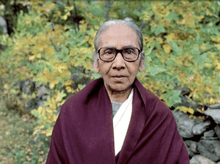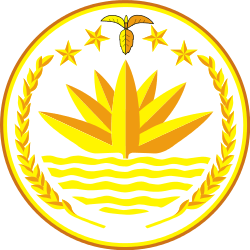Barua (Bangladesh)
| Total population | |
|---|---|
| 12,500[1] | |
| Regions with significant populations | |
|
| |
| Languages | |
| Bengali and Chittagonian | |
| Religion | |
| Theravada Buddhism |

Barua (Bengali: বড়ুয়া Boṛua, Arakanese: မရမာကြီး) is a distinct Bengali-speaking Tibeto-Burman and Indo-Aryan mixed ethno-religious minority group native to Chittagong Division in Bangladesh, Rakhine State in Myanmar, where they are known as the Maramagyi or Maramagri, and parts of Tripura in northeast India.[4][5] According to Arakanese chronology, the Barua Buddhists are the ancient peoples of Bangladesh who have lived there for five thousand years.[6] They are commonly identified by their last name, "Barua".
Chittagong was formerly known as "Chaityagrama" "town with Buddhist shrines".[7] It was a center of Mahayana Buddhism in the 10th century. Magh was the general term used for Buddhists; Barua's are also termed Rajbansi "of royal descent".
They insist that they came from the Aryavarta or the country of the Aryans which is practically identical to the country later known as Majjhimadesa or Madhyadesa in the Pali texts.[8] Bengali speaking Barua people of Chittagong are all Buddhist by religion, unlike Assamese Barua of Assam. Barua came from "Baru" "great" and "arya", meaning "noble ones".
A Magh king, Jaychand, ruled the Chittagong region in the 16th century.[9]
Theravada Buddhism

The Baruas used to follow Mahayana Buddhism and followed some of the Hindu customs until the mid 19th century when the Sangha Raja of Arakan, returning from Bodh Gaya, visited Chittagong.
In the mid 19th century, the Baruas came into contact with Theravada Buddhists from Burma and Ceylon and are now thus mainly followers of Theravada Buddhism.
Bauddha Dharmankur Sabha Buddhist religious organisation founded by Kripasharan Mahasthavir in Calcutta on 5 October 1892. Kripasharan Mahasthavir was its first president and Surendralal Mutsuddi its secretary. The journal of the Dharmankur Sabha, Jagajjyoti, edited by Gunalangkar Sthavir and Shraman Punnananda Swami, was first published in 1908. It was subsequently also edited by Benimadhab Barua.
Noted scholar Dr. Benimadhab Barua(1888-1948), was born in 1888 in the village of Mahamuni under Raozan Thana, Chittagong. He was the son of Kaviraj Rajchandra Talukder. Benimadhab assumed the title of ‘Barua’. In 1913 he obtained MA degree in Pali from University of Calcutta. He also studied law at Calcutta City College and Calcutta Law College. He became one of the pioneers of revitalization of Buddhism in the Barua Community. Benimadhab joined Mahāmuni Anglo-Pāli Institution as headmaster in 1912. From 1913-14 he worked as a lecturer in the Pāli department of the University of Calcutta. He went to England on a government scholarship in 1914. He earned an MA in Greek and Modern European Philosophy from the University of London. In 1917 he was awarded a D.Litt. by the University of London. He was the first Asian to do so.[citation needed] After returning to India in 1918, Benimadhab rejoined Calcutta University and was promoted to professorship. He improvised the syllabus of the MA course in Pali, apart from his work in the departments of Ancient Indian History and Culture (1919–48) and Sanskrit (1927–48) in the same university.[1] [10]
Anagarika Dharmapala visited Chittagong in 1917 where he influenced a 9-year-old boy, who later became the well known Pali scholar Prof. Dwijendra Lal Barua.[11]
See also
References
- ↑ https://joshuaproject.net/people_groups/16382
- ↑ https://joshuaproject.net/people_groups/16382/BG
- ↑ https://joshuaproject.net/people_groups/16382/IN
- ↑ The thousand-petalled lotus: an English Buddhist in India, Sangharakshita (Bhikshu), Heinemann, 1976, p. 265
- ↑ https://books.google.com.au/books?id=OzEOKNPsv2EC&printsec=frontcover#v=onepage&q&f=false
- ↑ http://www.buddhanet.net/e-learning/buddhistworld/bangladesh-txt.htm
- ↑ The Buddhists of Chittagong, Appendix to Chapter 3, Bengal district gazetteers, 1908, p. 65
- ↑ Buddhism in Bangladesh
- ↑ Magh raiders in Bengal, Jamini Mohan Ghosh Bookland, 1960p. 55
- ↑ Dr. B.M. Barua Birth Centenary Commemoration Volume, 1989, Bauddha Dharmankur Sabha, 1989
- ↑ Sugat Barua, The Maha Bodhi,1891-1991, Volumes 98-99; Maha-Bodhi Society, p. 307
